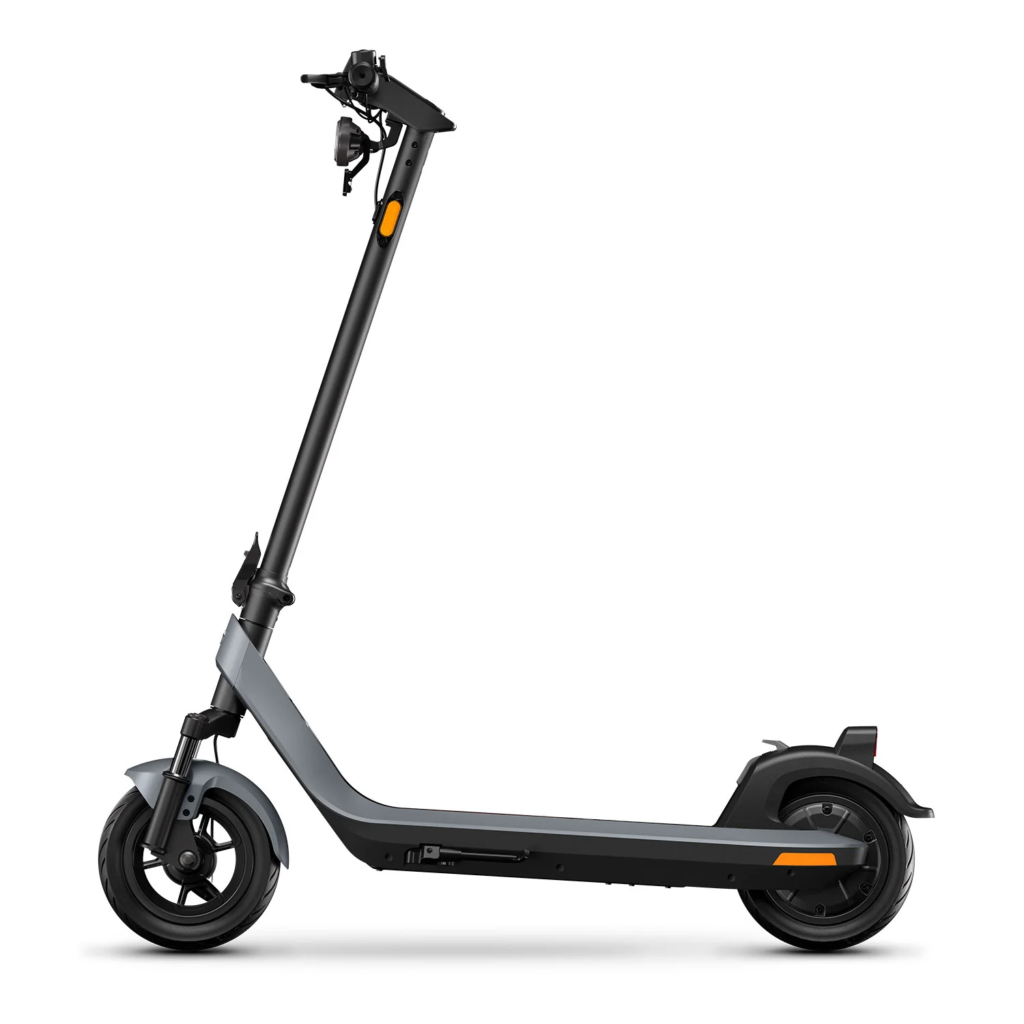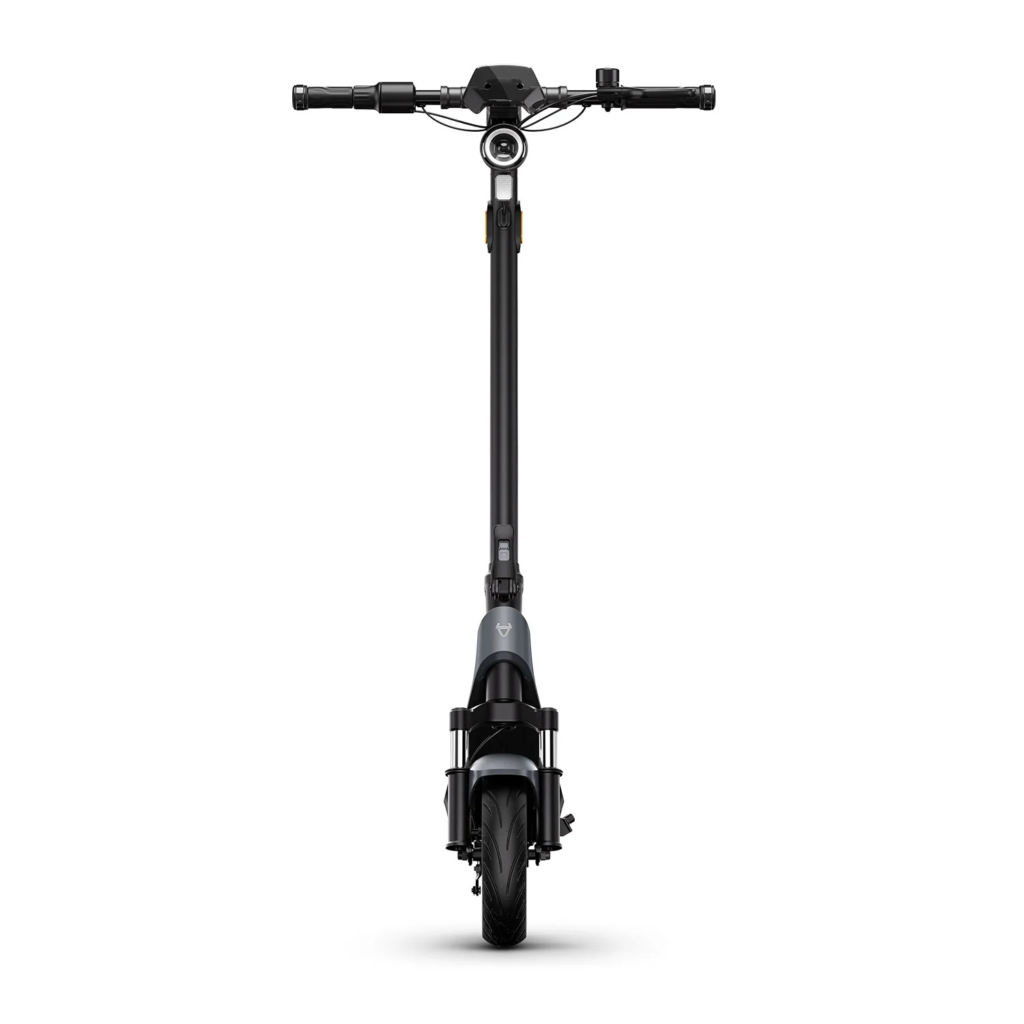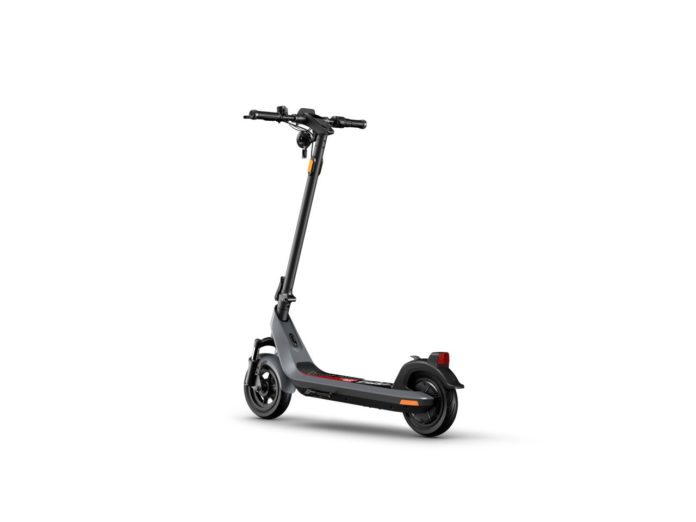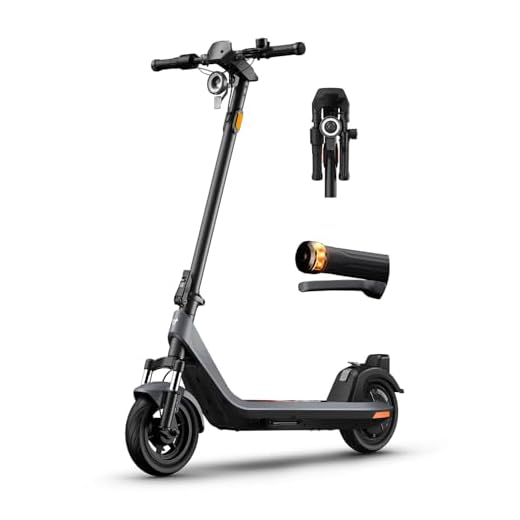Quick Take
The NIU KQi 200F aims squarely at everyday commuters who want a premium feel without the heft or complexity of sport-class scooters. It favors control over chaos, comfort over gimmicks, and consistency over peak numbers. As a result, it slots perfectly into daily city routines. The cockpit feels tidy. The deck is welcoming. The tires tame rough streets better than most budget rivals. Meanwhile, the brakes are predictable, and the app adds genuine value without getting in your way. Although it isn’t built for 30-mph blasts, it moves with purpose, holds pace on flats, and glides through bike-lane traffic with confidence. For a clean spec sheet and current details, see NIU KQi 200F — Specs & Details.
Who This Scooter Fits Best
Choose the KQi 200F if your riding circle includes bike lanes, neighborhood streets, and predictable pavement. Office commuters, college students, and errand runners will all appreciate its calm manners. New riders will love the smooth throttle ramp and friendly learning curve. Returning riders, on the other hand, will notice how much more planted it feels compared with bargain scooters. If you need extreme hill power or sustained high speed, look elsewhere. If you want a scooter that you can trust day after day, this one is right on target.
Design & Build Quality: Tight Where It Counts
The first lift tells you a lot. The KQi 200F feels cohesive. Panels line up cleanly and don’t buzz over seams. The stem locks down with confidence. The latch clicks into place without fuss. Because cable routing is disciplined, the cockpit looks neat and stays snag-free. Those little touches matter. They telegraph quality before you even roll.
Grips feel dense rather than foamy. Levers move with a precise, progressive pull. The display is legible in daylight and still clear at dusk. The deck rubber grips well even when shoes are damp. As a result, you stand naturally and ride with less micro-correction. The overall finish punches above the “light commuter” class and makes weekday rides feel like small upgrades to your routine.

Unboxing & Setup: Friendly and Fast
Assembly is straightforward. Handlebars mount in minutes. The latch is self-explanatory. The charging routine is typical: plug, confirm indicator, and wait for a full top-off before your first outing. Once powered, mode selection is obvious. The app pairing process is simple, too. You can ride without the app if you prefer, yet keeping it installed helps with diagnostics and lock features.
Before your maiden ride, align the bars to your natural shoulder width and tweak lever angle so your wrists stay neutral. Then, run a quick bolt check along the stem clamp and brake mounts. These two minutes up front save you from creaks later.
Performance & Power Delivery: Smooth, Predictable Thrust
The KQi 200F focuses on usable power, not marketing fireworks. Throttle response ramps in cleanly. Launches are composed rather than jumpy. That behavior builds confidence, especially for new riders who are still learning how their weight shifts as they accelerate. Because the curve is predictable, you leave stoplights smoothly and merge into bike-lane flow without wobble.
Cruising speed sits in the city-sensible band. You keep pace with cyclists and pass joggers without drama. On gentle inclines, the scooter holds speed well. On longer hills, speed naturally tapers. That’s normal for a lightweight, single-motor commuter. If your route includes big grades every day, a higher-output model may fit better. For mixed urban terrain, however, the 200F feels right at home.
Range & Battery Strategy: Consistency Over Hype
Range always depends on rider weight, wind, temperature, hills, and speed. Even so, the KQi 200F delivers consistent city miles when you ride with a steady hand. Its controller prioritizes efficiency, so you avoid big surges that waste energy. With moderate pacing, most riders can complete typical round trips and still keep a buffer for errands.
To stretch miles, follow a few easy habits. First, ride one mode lower when traffic is light. Second, check tire pressure weekly; underinflation eats range and comfort. Third, smooth your starts and roll toward lights rather than sprinting and braking. Finally, top up at work if your loop nudges your limit. These steps sound simple; however, they add miles every week without changing your routine.
For long-term battery health, avoid deep discharges whenever possible. Store the scooter at room temperature. After hot rides, let the pack rest a few minutes before charging. These tiny decisions protect your cells and preserve capacity month after month.
Ride Comfort: Tires, Geometry, and Stance
Suspension adds weight and complexity. Lightweight commuters often skip it. The KQi 200F instead leans on large pneumatic tires and smart geometry. The result feels surprisingly plush for this class. Cracks and seams shrink to a background buzz. Small debris loses its punch. You still steer around potholes, of course, but the day-to-day chatter that wears you down is filtered before it reaches your wrists.
Deck width matters, too. Because the deck allows a natural stance, you can shift your feet during longer rides. This simple adjustment reduces hotspots and knee fatigue. Meanwhile, a slightly forward lean with bent elbows turns your body into an active damper. With that stance, the scooter remains calm at speed and responsive at low speeds, even on patchy blocks.
Handling & Stability: Neutral, Not Nervous
Some light commuters feel twitchy at speed. The KQi 200F avoids that trap. Steering is neutral rather than hyper-quick. Small corrections are enough to keep a smooth line. The stem feels solid under load. Because geometry and tire size match, mid-corner bumps do less to unsettle the chassis. As a result, you ride with lighter hands, which lowers fatigue and raises confidence.
In tight spaces, the wide bar gives you leverage to thread through gaps. On descents, weight distribution remains balanced, so you don’t feel nose-heavy. These traits won’t headline a product page; nonetheless, they define daily happiness more than raw numbers.
Braking & Safety: Confidence by Design
Brakes are your real “performance” feature in a city. The KQi 200F uses mechanical discs backed by regenerative motor braking. When you roll off the throttle, regen adds gentle drag and stabilizes the chassis. Then the pads bite predictably. Lever feel is progressive, so you can modulate easily rather than grabbing and praying. That combination shortens stops and builds trust.
Practice still matters. On day one, spend five minutes in an empty lot. Do progressive stops from different speeds. Learn the lever throw. Feel the tires load and settle. As a result, you will know your stopping distances in dry, damp, and wet conditions before you ride in traffic.
Lighting is part of safety, too. The headlight throws a clear beam that helps you read the road. The rear light responds under braking. Side reflectors increase your 360-degree profile. For night-heavy routes, add a brighter bar light and an extra rear flasher on your backpack. Redundancy makes you easier to see in complex traffic.
Portability: Manageable Size, Real-World Fold
Battery capacity adds pounds, yet the KQi 200F stays manageable for stairs, elevators, and trunk duty. The fold is quick, and the latch engages without a fight. Handlebars remain wide for stability, but they don’t feel ungainly in narrow entries. If you carry it frequently, consider a soft handle wrap or strap to save your palms and protect your jacket. For most riders, though, rolling it rather than lifting it will be the default.
Storage is easy. The scooter tucks under a desk, next to a filing cabinet, or into a trunk without dominating the space. A small door mat at home catches drips on rainy days and keeps grit off floors. These simple tricks reduce friction and make you more likely to ride often.

Controls, Display, and App: Useful, Not Fussy
The KQi 200F keeps controls simple. Power, mode, and lights are right where you expect. The display shows the essentials at a glance. Because the interface is straightforward, you spend less time fiddling and more time riding. That alone lowers cognitive load in traffic.
The companion app adds tools you will actually use. You can lock the scooter, view ride logs, check basic diagnostics, and apply firmware updates. Critically, you can ride without the app if you prefer analog simplicity. However, having it installed turns ownership into a more organized, trackable experience.
Weather & Water: Sensible Boundaries
Treat the KQi 200F as splash-resistant, not waterproof. Light rain is manageable with care. Heavy downpours, standing water, and pressure washing are not. After wet rides, wipe down the deck and dry the charge port. Store the scooter indoors so connectors stay clean.
In the rain, lower your speed and ride smoother lines. Avoid painted symbols and metal plates, which are slick when wet. If your area gets frequent storms, add a brighter headlight and an auxiliary rear flasher. As always, visibility is your friend.
Daily Ownership: What Holds Up After Month Three
Light commuters sometimes rattle themselves loose by week six. The KQi 200F does better. The latch retains its snap. The stem remains quiet. Brakes bed in and then require only small adjustments. Tires hold bead well, and PSI checks become routine rather than a chore. Because the scooter starts with a strong baseline, it stays dialed with minimal attention.
The app’s logs become helpful over time. You can track seasonal range, compare different routes, and see how tire pressure affects efficiency. That data is simple; nevertheless, it informs better habits and smarter maintenance.
Maintenance: A Fast Monthly Ritual
Fifteen or twenty minutes each month keeps the KQi 200F in peak form.
- Torque check: Stem clamp bolts, axle nuts, caliper mounts, and rotor hardware.
- Brake tune: Confirm lever throw, pad alignment, and rub-free spin; adjust cable tension if the bite point drifts.
- Tires: Inspect tread, remove embedded debris, and set PSI in the recommended range.
- Battery care: Avoid deep discharges, keep the charge port dry, and store indoors at room temperature.
- Cleanliness: Wipe dust, purge grit from the latch area, and check cable housings for wear.
- Test loop: Do a short ride with a few controlled stops and one quick acceleration to confirm everything feels right.
These quick tasks prevent minor issues from turning into expensive fixes.
Accessories That Actually Help
- Helmet: Choose a lightweight commuter model with ample vents.
- Lights: Add a brighter bar light and a secondary rear flasher for redundancy.
- Lock: Pair the app lock with a compact U-lock or hardened chain for café stops.
- Phone mount: Use a vibration-damping mount if you navigate by map.
- Portable pump: Keep a mini pump or CO₂ inflator and pressure gauge in your bag.
- Gloves: Padded palms reduce fatigue on rough corridors.
- Fender flap: If your city puddles often, a small flap prevents back spray.
Every item should earn its carry weight. If it saves time or improves safety, keep it.
Comparisons: Where the KQi 200F Lands
Versus NIU KQi 200P
The 200P is the approachable base of the family. The 200F refines that template. It feels more composed at speed, offers a tidier cockpit, and adds a premium touch to the contact points. If you prize stability and finish, the 200F is the smarter long-term pick.
Versus NIU KQi 300P
The 300P steps up with an even more planted stance and a stronger premium feel. It suits riders who want a bit more muscle and richer contact points. For a deep dive into that model’s strengths, check our dedicated write-up: NIU KQi 300P — Premium Commuting Without the Bulk.
Versus Segway Ninebot “MAX-class” scooters
Segway’s MAX-class models bring massive ecosystem support and long-proven reliability. NIU counters with a cockpit that often feels richer in the hands and an app that is equally polished. If local dealer support drives your choice, Segway has the edge. If bar feel and finish matter more, the 200F deserves a serious look.
Versus value brands
Budget scooters can undercut the 200F on price. However, they frequently give up stem stiffness, brake quality, and cable management. The 200F costs more upfront, yet it pays you back daily with better control, comfort, and long-term durability.
Buying Advice: Map Your Route, Then Decide
Before you buy, audit your commute. How many miles? How many hills? Which blocks are roughest? Then, match the scooter to that reality. If your loop is short and flat, you can ride in efficiency modes and charge every other day. If your loop includes several rises, plan on daily top-ups. Also, decide where the scooter will live. If you must carry it upstairs, test a lift in a showroom. Balance and handhold comfort matter as much as the number on the scale.
Budget for essentials from day one. A well-fitting helmet, an extra light, and a compact lock should sit in the cart with the scooter. Add a mini pump and a multi-tool. With that kit, you’ll solve most problems in minutes rather than hours.
Sustainability & Long-Term Ownership
Electric scooters reduce car trips and ease congestion on short hops. However, sustainability also means durability and serviceability. The KQi 200F helps on both counts. Its tidy routing protects cables. Its latch hardware feels robust. Its contact points resist wear. Replace tires and pads on schedule, keep fasteners tight, and store the scooter indoors. With those habits, you extend lifespan and cut waste while saving money.
Common Mistakes to Avoid
- Running low tire pressure: It kills range and comfort and invites pinch flats.
- Over-tightening stem hardware: It can deform parts and create creaks; use gentle torque.
- Ignoring rotor rub: Drag wastes energy and heats components; realign pads promptly.
- Charging while damp: Moisture corrodes ports; dry the scooter before plugging in.
- Parking in direct sun: Heat ages cells and plastics; seek shade or bring it inside.
Avoid these pitfalls and your 200F stays quiet, tight, and efficient.
Pros & Cons
Pros
- Calm, predictable throttle mapping for city riding
- Quality brakes with useful regenerative assist
- Large pneumatic tires that smooth daily chatter
- Tidy cockpit, grippy deck, and premium touch points
- App features that add real value without friction
- Manageable weight and quick, confidence-inspiring fold
Cons
- Not built for extreme hills or 30-mph speed runs
- Carry weight is still noticeable on long stair climbs
- No full suspension; you still pick clean lines on broken pavement
- Range, like any commuter’s, shrinks in cold weather and strong headwinds
FAQs
Is the NIU KQi 200F good for daily commuting?
Yes. It blends smooth power, stable handling, and reliable brakes. As a result, it excels in bike lanes and on neighborhood streets.
How fast does it go?
It targets practical city speeds. Local rules, rider weight, and terrain affect the exact number. The goal is control and consistency rather than peak velocity.
How far can I ride on one charge?
Expect solid commuter miles at moderate speeds, especially with proper tire pressure and smart pacing. Hills, cold air, and headwinds reduce range, as usual.
Does it have suspension?
It relies on large pneumatic tires and balanced geometry. Consequently, it rides smoother than many budget scooters without adding suspension weight.
Is it heavy?
It is manageable for stairs and trunks, although you will feel the battery mass on long carries. The fold is compact, which helps in tight spaces.
What maintenance does it need?
Monthly torque checks, brake alignment, fresh PSI, and a quick wipe-down cover most needs. With fifteen minutes of care, it stays dialed and quiet.
Can I ride it in the rain?
Treat it as splash-resistant. Light rain is okay with caution. Deep puddles and pressure washing are not. Dry the port and store indoors after wet rides.
Final Verdict
The NIU KQi 200F proves that a light commuter can feel premium without getting complicated. It rides quietly. It stops with confidence. It looks clean and stays composed when streets turn rough. Most importantly, it transforms daily miles into a predictable routine you can rely on. If you want a refined, modern commuter that values control, comfort, and durability, the KQi 200F belongs near the top of your list.



